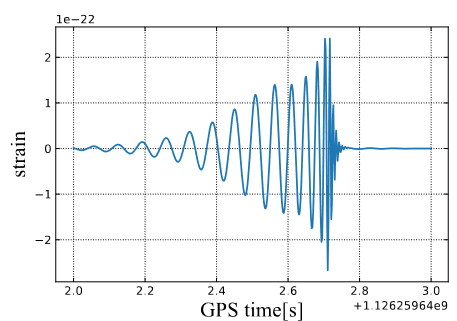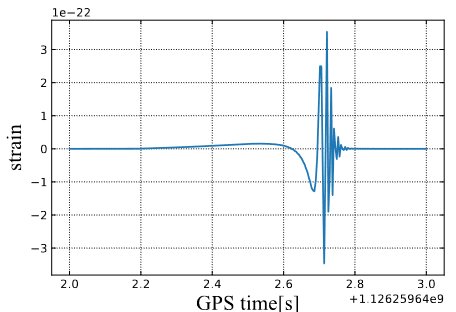A couple of months ago a student who I’ve been working with for the last year or so put out a new first author paper, which was an exciting moment. This is the first time I’ve had a student publish, so I’m enjoying a little buzz of excitement from that, but Weichangfeng should enjoy all the glory of getting the project finished.
You can find the new paper on the arxiv, but I’ll give a quick rundown of what we did in this post.
Most of the analyses and searches which we conduct for gravitational waves are designed to find merging compact objects; most of what we find are pairs of black holes merging, but we also see black holes and neutron stars merging, and also pairs of neutron stars merging. An important, but normally reasonable, assumption that we make is that these signals are from black holes in circular or very-nearly circular orbits about one another just before they merge. Normally that assumption should be fine, and the methods which we use to analyse gravitational wave signals making this assumption should be assumed to produce accurate inferences about the system which produced the gravitational wave.
This paper investigates a situation where we think this assumption might break down, and produce unexpected results, and ultimately misinterpret the source of the signal. To understand the source of this potential problem we need to know a little about what gravitational wave signals look like. The “shape” of a gravitational wave (that is, the pattern of stretching and squeezing it produces in spacetime as time passes) is called its waveform. For a pair of black holes colliding and merging after a long period of orbiting one another this has a distinctive and well-known form.

We often divide the waveform into three sections; the inspiral, which is the leftmost part (and therefore the part earliest in the evolution of the system), which is produced as the two objects are still orbiting each other; the merger, which is the part immediately around the peak, where the two black holes touch and then combine; and the inspiral, which is the last part of the waveform, and produced by the final black hole radiating excess energy. The first plot, which I’ve taken from the paper, shows what we expect one of these BBH signals to look like. The normal systems we try to observe have this pattern, as the two black holes have orbited each other for a (very) extended period of time, and continue to do so right up until they collide and merge.
However, it is also possible for two black holes to “meet” in spacetime, perhaps orbit each other once or twice, and then merge. The waveform for this sort of event will look different compared to our “standard” BBH, because it won’t have many many cycles of radiation produced by a slow inspiral, but instead will have just one or two.

So far, looking at these two waveforms it’s fairly easy to tell that one is different from the other, but in reality we’re faced with an additional and considerable limitation. Our detectors are only able to observe a limited range of frequencies in the signal. We can therefore imagine a situation where part of the signal is missing because it is unobservable rather than because it isn’t present. The frequency at which the two black holes merge in a normal BBH is dictated by their masses. The diameter of a black hole is directly determined by its mass, and the merger phase of the waveform starts around the time that the two black holes come into contact with each other. Smaller black holes can get closer to each other before merging than larger, more massive ones can, and they can therefore make smaller orbits around each other, and produce higher frequency gravitational waves.
If we have a pair of black holes with masses large enough that they only produce one or two inspirals at observable frequencies we have a potential source of confusion. This paper looks at this, and whether it’s possible to distinguish the two types of signal.
One obstacle Weichangfeng faced when preparing for this project was performing enough analyses to be able to come to any conclusions. The conventional method for gravitational wave data analysis can take days or even weeks to give a result when given a single event, and we needed to look at hundreds of events in order to make a statistical statement about our ability to discern the two types of event. To get around this we make use of Vitamin which is a machine learning tool which approximates the same process. We used Vitamin to analyse injected signals, and then looked at how the results compared.
Our method compares the posterior probability distributions from the analyses in order to identify whether the results from analysing a binary black hole signal are noticably different from analysing an encounter using the same assumptions. This means that we’re analysing the binary black hole signal with the correct model, but the encounter with the incorrect one.
What we found was that for detections made with the sensitivity of current detectors, such as the LIGO detectors, an injected encounter waveform will often be recovered and identified as a high-mass, spinning binary black hole, but that we’re not able to easily distinguish an encounter from a legitimate high-mass spinning system. While that might initially seem disappointing, we think it’s an important result; as the number of detections increases we’re likely to start seeing more unusual high-mass systems, and therefore we need to be vigilant to the possibility that these signals may not be generated by binary black holes, but could instead be a more exotic black hole encounter.
Eventually, with future detectors which are more sensitive to low frequencies, we’ll be able to distinguish an encounter from a genuine binary, since we’ll know that the lack of observed inspiral isn’t simply due to a defficiency of the observation. But until then we’ve at least done something to muddy the waters of a specific part of binary blak hole parameter space!
The research in this paper was made possible by support from the STFC in the UK, the National Research Foundation of Korea, the National Natural Science Foundation of China, amongst others (see the paper acknowledgements for a comprehensive list). We are also indebted, as ever, to our colleagues both in our own institutions and in the LIGO, Virgo, and Kagra collaborations.
The preprint of the paper can be found on the arxiv.